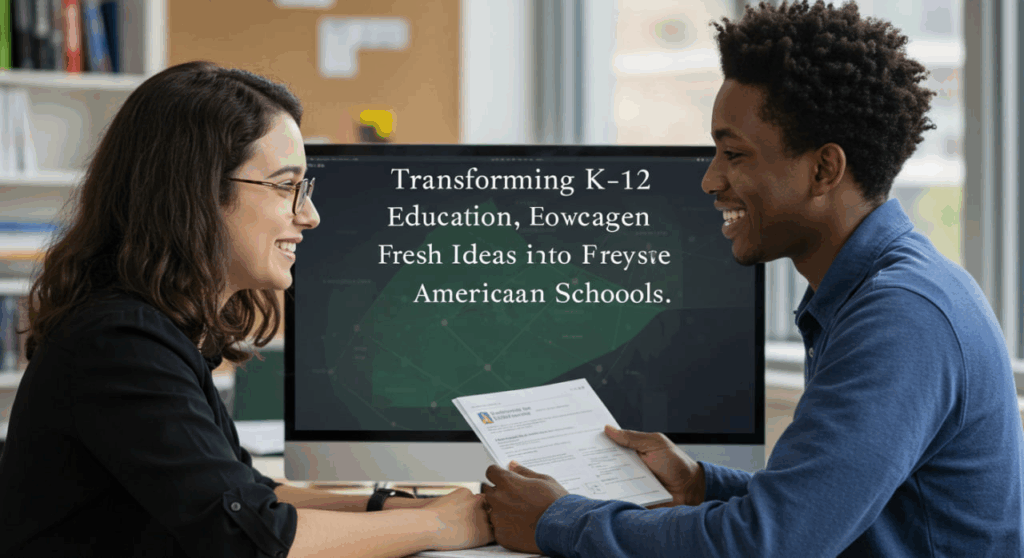Introduction
It is a radical change in the landscape of K-12 education in America when educators and policymakers, in addition to technology innovators, attempt to incorporate new approaches and resources in classrooms. It is not about perfecting the way things are done but the way in which students will be taught and therefore being prepared to face the problems of the future. The article examines some of the most promising and innovative ideas that are currently being used or proposed in the American schools.
Utilization of Technology in Classroom
Blended Learning Models
The mixture of face-to-face classroom and online instructions (blended learning) is also growing in popularity. Social learning sites such as Khan Academy and Edmodo offer interactive tools; they also offer individualized, personalized options that address the needs of individual students. Not only do these platforms provide numerous educational resources, but also help to communicate among teachers, students, and parents.
AR and VR Augmented and Virtual Reality (AR and VR) The two further major terms are the Augmented and Virtual reality (AR and VR). The AR technology creates a situation or experience that incorporates an existing reality with a computer generated experience in real time. The latter technology, the Virtual reality (VR) is more or less, the same as the former one (AR), which can be defined, as a situation or experience that takes an existing reality into consideration and couples it with a computer generated experience in real time.

AR and VR technologies are changing the way we can teach subjects such as history, science, or even art. VR enables students to visit historical events, geographical destinations or even scientific processes virtually as though they are present. As an example, a biology lesson could be introduced with VR as a new way to travel to the inside of a human cell or observe endangered animals in their natural living conditions. AR adds to this by superimposing virtual information into a real situation, augmenting textbooks and classroom items with further layers of educational information.
Individual Learning Pathways
No two students learn the same and the standard education policy of a one-size fits all approach is usually blamed as lacking behind in addressing learning needs across the board. Individual learning pathways overcome this challenge by differentiating learning to the advantages and limitations of the students. Adaptive learning programs modify the complexity and kind of material served relative to the amount of work that each student does, and thus, each child learns at a rate that they are most comfortable with.
focusing on the development of Soft Skills
Modern educational practice emphasizes the gain of so-called soft skills soft-skills, such as critical thinking, creativity, collaboration, communication, in addition to core academic competencies. Advanced programs such as Project-Based Learning (PBL) promote students to undertake complex projects which demand that the students use cross-disciplinary approaches and abilities. Cooperative solving of real-world problems helps the students not only acquire knowledge but also enhances interpersonal and problem-solving skills that will be of great help in their life in whichever career they undertake.
Promoting Inclusive and equitable settings
Establishment of an egalitarian and unifying learning environment is vital in giving all the students a chance to prosper. This incorporates addressing those issues that can intervene with quality education access, including racial and economic differences. Some of the strategies include instituting more support of disadvantaged students and instituting cultural competency training among teachers. Moreover, creating a feeling of belonging among the students of diversified backgrounds, can contribute to the creation of a community that can resolve the feeling of being important and heard by everyone.
Groupwork and neighborhood organizations
Learning cannot be limited in the walls of a school; it only excels when it is incorporated into society. School and local business, museum, libraries and non-profit partnerships offer students enhanced learning opportunities and actual life experiences. Collaborative efforts may be interns, job shadowing, and guest lecturers, community service projects etc., just to mention a few of the examples.
FAQ Section
How does using blended learning models benefit K-12 education?
Blended learning models have a number of advantages such as better flexibility, individualized experiences and more engagement due to multimedia and interactive features.
How does VR improve learning in the classroom?
VR is a way to improve the process of learning by simulating immersive experiences and bringing intangible concepts to life. It offers a hands-on aspect of learning impossible to achieve using conventional approach, thus enhancing the acceptance and retention of the knowledge.
Why is the importance of soft skills necessary in K-12 education?
Critical thinking, creativity, and communication are soft skills that are necessary to achieve success in academic or professional life. They provide a skill to those students to be flexible in varying situations and work with others in a cooperative manner.
How can community participation help in the K-12 revolution?
Community involvement introduces the outside world to our classrooms providing our students with real-life applications to what they are studying. It has the effect of developing a nurturing environment around students as well, allowing their overall growth.
Introducing these new methods in the American schools would prepare the students to face a constantly shifting world in a better way. Whether we reach the final stage of change through K-12 education or not, we can be sure that with effort and constant progress we will provide every child with the best education on the planet and enable them to explore their potential and make this world a better place.



